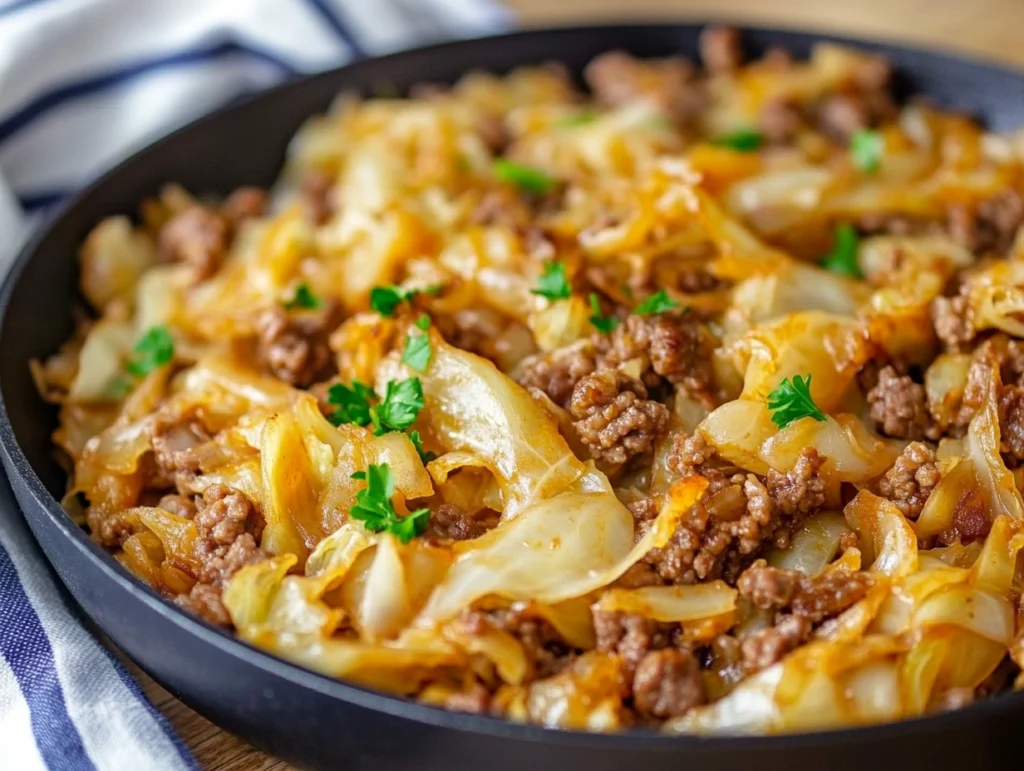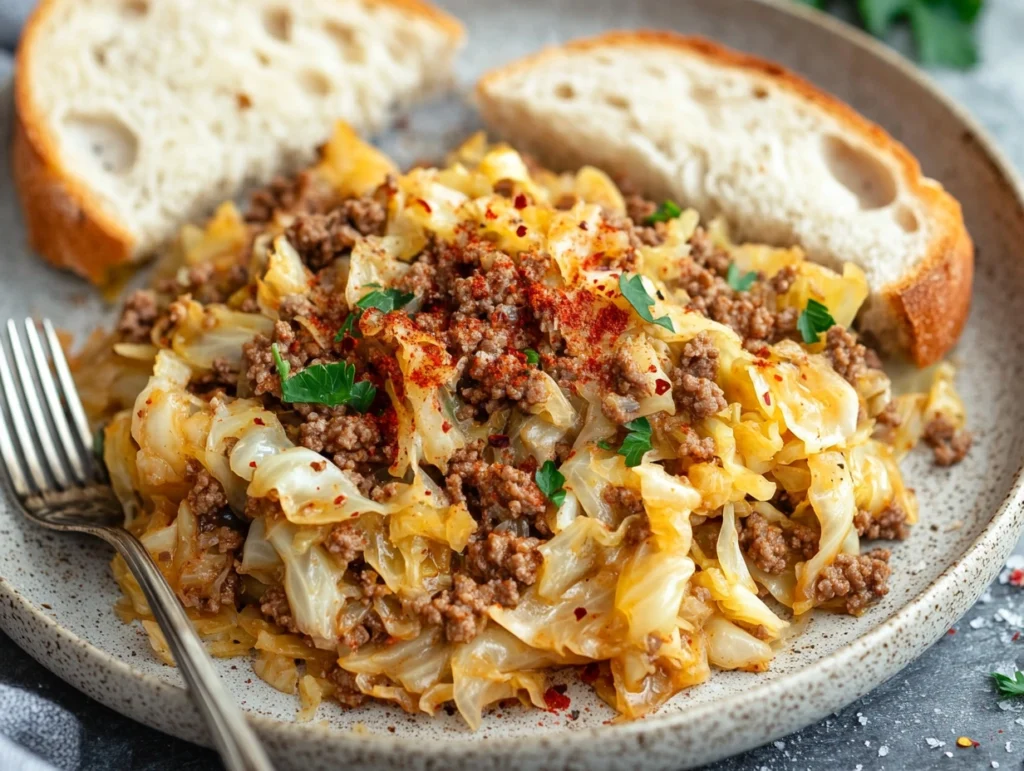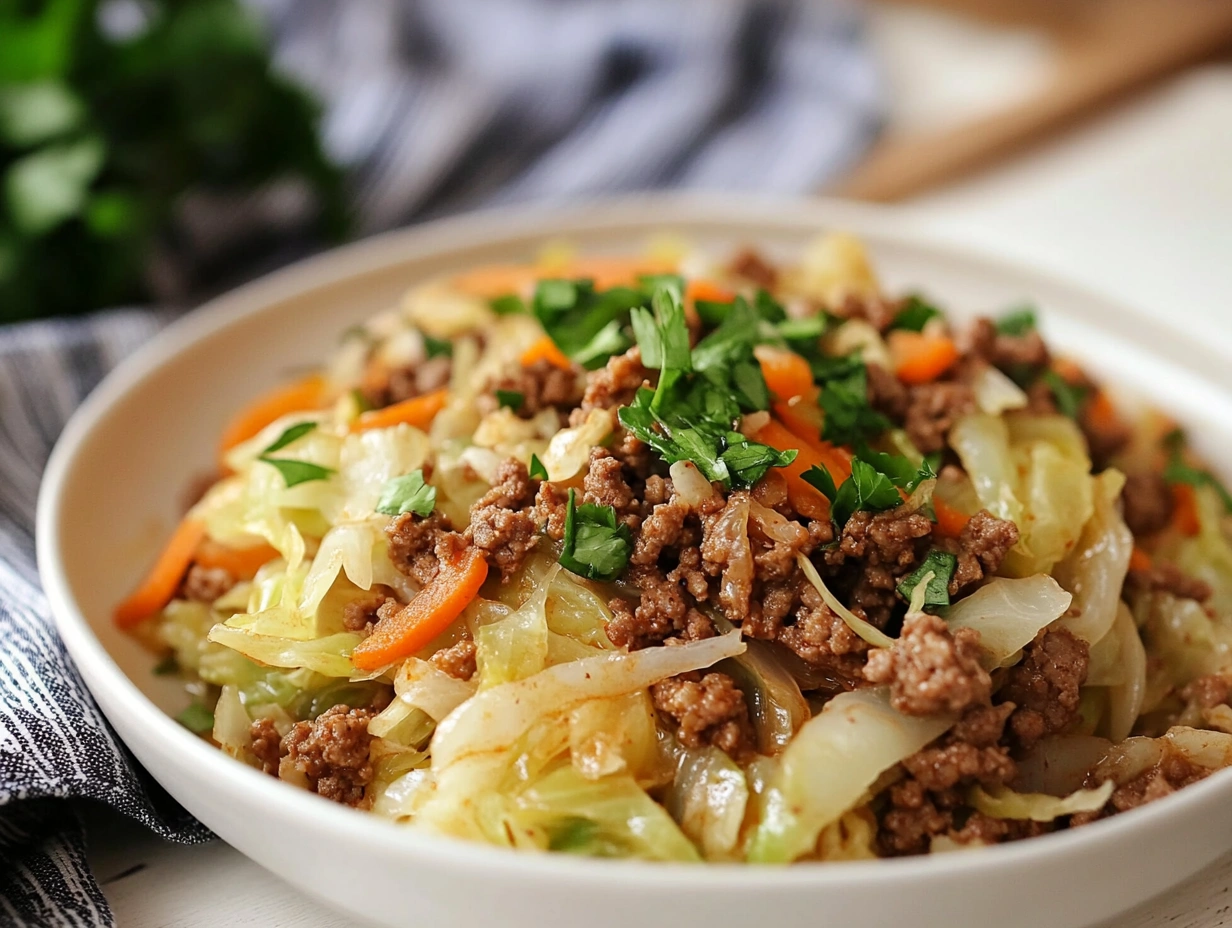Table of contents
- 1. Introduction
- 2. What is a Ground Beef Cabbage Recipe?
- 3. Ingredients Overview
- 4. Step-by-Step Instructions for Preparing the Recipe
- 5. Why Do You Soak Cabbage Before Cooking?
- 6. Why Do You Put Vinegar in Cabbage When Boiling It?
- 7. Can You Cook Ground Beef and Veggies in the Same Pan?
- 8. How Do You Keep Cabbage Crispy When Cooking?
- 9. Flavor Variations and Add-Ins
- 10. Health Benefits of Ground Beef and Cabbage
- 11. Storage and Reheating Tips
- 12. FAQs
- 13. Nutritional Analysis
- 14. Conclusion
1. Introduction
Finding a meal that is quick, healthy, and delicious can sometimes feel like a challenge. The ground beef cabbage recipe offers all these qualities and more. With its hearty flavor and versatile nature, this dish is perfect for busy households looking for a comforting dinner option.
Combining the rich taste of seasoned ground beef with the earthy crunch of fresh cabbage creates a balance of flavor and texture that satisfies every palate. Whether you’re a seasoned home cook or just starting out, this recipe is an excellent addition to your repertoire.
2. What is a Ground Beef Cabbage Recipe?
At its core, a ground beef cabbage recipe is a combination of seasoned ground beef and tender cabbage, cooked together to perfection. This dish is incredibly versatile, appearing in various cuisines across the globe.
- Traditional Variations: In Eastern European cooking, it may take the form of stuffed cabbage rolls. Asian cuisines might use it in stir-fries, while American interpretations often involve hearty casseroles.
- Modern Adaptations: Today, variations include keto-friendly skillet versions, slow-cooker meals, or even deconstructed versions of classic cabbage rolls.
This dish’s universal appeal lies in its adaptability. You can keep it simple with just a few ingredients or add spices and vegetables for a more complex flavor profile.
3. Ingredients Overview
A ground beef cabbage recipe is built on simple, easily accessible ingredients that deliver incredible flavor. Below is a typical ingredient list:

Alt Text: Raw cabbage and ground beef with cooking ingredients.
- Ground Beef: Choose lean or regular ground beef based on your preference. For a healthier option, consider ground turkey or chicken.
- Cabbage: Green cabbage is the go-to choice, but savoy or napa cabbage can add a unique twist.
- Onions and Garlic: These aromatic ingredients enhance the flavor of the dish.
- Tomatoes (Optional): Fresh tomatoes or canned diced tomatoes add a slight tang and richness.
- Seasonings: Salt, pepper, paprika, and thyme are commonly used. Feel free to include spices like cumin or chili flakes for extra heat.
- Oil or Butter: Used for sautéing the vegetables and meat.
- Optional Add-Ins: Bell peppers, carrots, or even a dash of soy sauce for a fusion touch.
This recipe’s charm lies in its flexibility. You can adjust the ingredients based on dietary preferences or what you have in your pantry.
4. Step-by-Step Instructions for Preparing the Recipe
4.1. Preparation
- Cabbage: Wash the cabbage thoroughly, remove the tough core, and chop it into bite-sized pieces. Soaking the cabbage in cold water for 10 minutes can help maintain its crispness.
- Ground Beef: If necessary, thaw the ground beef and season lightly with salt and pepper.

Alt Text: Ground beef and cabbage in a skillet garnished with parsley.
4.2. Cooking Instructions
- Sauté Aromatics: Heat a large skillet or wok over medium heat. Add a splash of oil or butter, followed by chopped onions and minced garlic. Cook until fragrant and golden.
- Cook the Beef: Add the ground beef to the skillet. Break it apart using a wooden spoon and cook until browned and fully cooked. Drain any excess grease if necessary.
- Add Cabbage: Stir in the chopped cabbage. Toss to coat it evenly with the beef and aromatics. Cover the skillet and allow the cabbage to wilt slightly.
- Season the Dish: Add your chosen spices and optional ingredients like diced tomatoes or carrots. Stir well to combine.
- Simmer: Lower the heat and let the dish cook for 8–10 minutes, stirring occasionally, until the cabbage is tender yet still crisp.
4.3. Serve and Enjoy
- Serve hot as a standalone dish or alongside rice, noodles, or bread for a more filling meal.
5. Why Do You Soak Cabbage Before Cooking?
Soaking cabbage before cooking is a simple yet effective step that improves the dish in several ways:
- Cleans the Leaves: Soaking removes dirt, pesticides, and any hidden debris, especially if you’re using organic or homegrown cabbage.
- Improves Texture: Soaking cabbage in cold water helps maintain its crispness. It’s especially useful if the cabbage has started to wilt.
- Reduces Bitterness: For some, cabbage can have a slight bitter taste. Soaking can help to mellow this flavor, especially in older cabbage.
To soak cabbage, fill a large bowl with cold water, add a teaspoon of salt or vinegar, and let the chopped cabbage sit for about 10 minutes. Rinse thoroughly before cooking.
6. Why Do You Put Vinegar in Cabbage When Boiling It?
Adding vinegar to cabbage during the cooking process is a tried-and-true culinary practice. Here’s why:
- Preserves Color: Red cabbage, in particular, retains its vibrant hue when vinegar is added. Without it, the cabbage might turn dull.
- Balances Flavor: Vinegar introduces a tangy note that complements the natural sweetness of cabbage.
- Reduces Odor: Boiled cabbage can produce a strong sulfuric smell. Vinegar helps neutralize this and makes cooking more pleasant.
To use vinegar, add one to two teaspoons per quart of water when boiling cabbage. This small addition makes a big difference in both appearance and flavor.
7. Can You Cook Ground Beef and Veggies in the Same Pan?
Absolutely! Cooking ground beef and vegetables in the same pan is a convenient, time-saving method that enhances flavor. Here’s why it works so well:
- Enhanced Flavor: As the ground beef cooks, it releases flavorful juices that season the vegetables. This creates a rich, cohesive taste.
- Fewer Dishes: One-pan cooking means less cleanup—a major win for busy cooks.
- Efficient Cooking: Ground beef and cabbage have similar cooking times, making them ideal for preparing together.
Tips for Success:
- Cook ground beef first and drain any excess fat to avoid greasiness.
- Add vegetables like cabbage, bell peppers, or carrots afterward, as they cook quickly.
- Stir frequently to ensure even cooking and seasoning.
This method is perfect for recipes like skillets, stir-fries, or casseroles, where all ingredients need to blend seamlessly.
8. How Do You Keep Cabbage Crispy When Cooking?
Maintaining the crispiness of cabbage during cooking requires attention to technique and timing. Here are some tips to keep your cabbage crunchy and delicious:
- Don’t Overcook: Cabbage cooks quickly. Aim for a cooking time of 5–10 minutes, depending on the method.
- Use High Heat: Stir-frying or sautéing at high heat locks in texture while cooking the cabbage evenly.
- Add Cabbage Last: When making one-pan dishes, add cabbage toward the end of cooking to prevent it from becoming too soft.
- Avoid Too Much Liquid: Excess water or broth can make cabbage soggy. Drain liquids promptly if they accumulate.
Quick cooking methods, such as stir-frying or steaming, are ideal for preserving cabbage’s natural crunch. For added texture, you can also lightly char the edges of the cabbage in a hot skillet.
9. Flavor Variations and Add-Ins
One of the best aspects of a ground beef cabbage recipe is its versatility. You can easily customize the dish to suit your preferences or try new flavor profiles.
Spices and Herbs
- Add paprika and garlic powder for a smoky touch.
- Incorporate cumin and chili powder for a Southwestern twist.
- Use fresh thyme, parsley, or dill for an herbal boost.
Additional Vegetables
- Bell peppers add sweetness and color.
- Carrots provide a natural sweetness and vibrant orange hue.
- Mushrooms contribute an earthy, meaty flavor that complements ground beef.
Cheese and Sauces
- Top with shredded cheddar, mozzarella, or Parmesan for added richness.
- Stir in soy sauce or Worcestershire sauce for deeper umami flavor.
- Add a dollop of sour cream or Greek yogurt when serving for a creamy finish.
Grains and Starches
- Mix in cooked rice, quinoa, or couscous for a heartier meal.
- Serve the dish over mashed potatoes or alongside crusty bread.
These variations allow you to make the recipe your own while exploring exciting new tastes.
10. Health Benefits of Ground Beef and Cabbage
This recipe isn’t just delicious—it’s packed with nutritional benefits. Here’s why it’s a great choice for your next meal:
Ground Beef
- A rich source of high-quality protein, essential for muscle repair and energy.
- Provides important nutrients like iron, zinc, and vitamin B12.
- Opt for lean ground beef to reduce saturated fat intake.
Cabbage
- Low in calories and high in fiber, making it a perfect addition to a balanced diet.
- Packed with vitamins C and K, supporting immunity and bone health.
- Contains antioxidants that may help protect against certain diseases.
Combined Benefits
- Together, ground beef and cabbage form a balanced meal with protein, fiber, and vital nutrients.
- Adding vegetables like carrots or bell peppers enhances the dish’s overall nutritional value.
This recipe is ideal for those seeking a wholesome, nutrient-dense option that doesn’t compromise on flavor.
11. Storage and Reheating Tips
Proper storage and reheating are essential for preserving the flavor and texture of your ground beef cabbage recipe. Follow these tips to ensure your leftovers taste as good as fresh:

Alt Text: A serving of ground beef cabbage recipe with bread.
Storage Guidelines
- Refrigeration: Place the dish in an airtight container and store it in the fridge for up to 3–4 days.
- Freezing: For longer storage, freeze the cooked dish in a freezer-safe container for up to 2–3 months. Label it with the date for easy tracking.
Reheating Instructions
- Stovetop: Reheat in a skillet over medium heat, adding a splash of water or broth to prevent drying out.
- Microwave: Heat in a microwave-safe dish, stirring halfway through to ensure even heating. Use a microwave cover to retain moisture.
- Oven: If reheating a larger portion, place it in an oven-safe dish, cover with foil, and heat at 350°F until warmed through.
Tips for Best Results
- Avoid overcooking during reheating to prevent the cabbage from becoming too soft.
- If frozen, thaw the dish in the refrigerator overnight before reheating for optimal texture.
Proper storage and reheating make this dish perfect for meal prep, ensuring a quick and tasty meal anytime.
12. FAQs
Why do you soak cabbage before cooking?
Soaking cabbage helps clean it thoroughly, improves its texture, and reduces bitterness, especially in older leaves.
Why do you put vinegar in cabbage when boiling it?
Adding vinegar preserves color, balances flavor, and reduces the sulfuric odor often associated with boiled cabbage.
Can you cook ground beef and veggies in the same pan?
Yes, cooking them in the same pan saves time, enhances flavor, and minimizes cleanup. Cook the ground beef first, then add vegetables.
How do you keep cabbage crispy when cooking?
To keep cabbage crispy, avoid overcooking, use high heat, and add the cabbage toward the end of cooking. Quick methods like stir-frying are ideal.
13. Nutritional Analysis
Here’s a breakdown of the nutritional value for a typical serving of the ground beef cabbage recipe:
| Nutrient | Amount per Serving |
|---|---|
| Calories | 250–300 kcal |
| Protein | 20–25 g |
| Total Fat | 10–15 g |
| Saturated Fat | 4–6 g |
| Carbohydrates | 8–12 g |
| Fiber | 3–5 g |
| Sugar | 3–5 g |
| Vitamin C | 50–70% of DV |
| Vitamin K | 60–80% of DV |
| Iron | 15–20% of DV |
Notes:
- The exact values may vary depending on the specific ingredients and portion sizes.
- Adding extras like cheese or grains will increase calorie and carbohydrate content.
This dish offers a great balance of macronutrients while being rich in essential vitamins and minerals. It fits well into low-carb and high-protein diets, making it suitable for various lifestyles.
14. Conclusion
The ground beef cabbage recipe is a true testament to the beauty of simplicity in cooking. With its minimal ingredients, ease of preparation, and adaptability, it’s a meal that checks all the boxes.
Whether you’re looking for a quick weeknight dinner, a budget-friendly option, or a nutritious dish to share with family and friends, this recipe is a winner. Plus, its versatility allows you to customize it with your favorite flavors and ingredients.
Give this recipe a try, and let it become a staple in your meal rotation. Don’t forget to experiment with variations and share your creations with others. Cooking can be both delicious and rewarding, especially with dishes like this.

